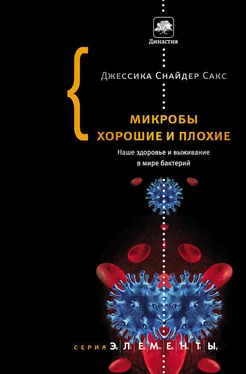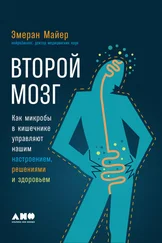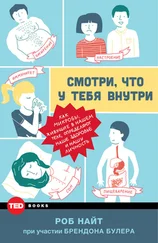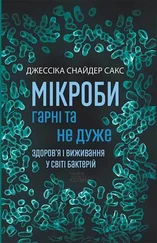59 Rolf Halden et al., “Co-occurrence of Triclocarban and Triclosan in U. S. Water Resources”, Environmental Science and Technology 39 (2005), 1420–1426; Jochen Heidler et al., “Partitioning, Persistence and Accumulation in Digested Sludge of the Topical Antiseptic Triclocarban During Wastewater Treatment”, Environmental Science and Technology 40 (2006), 3634–3639.
60 Holli Lancaster et al., “Prevalence and Identification of Tetracycline-Resistant Oral Bacteria in Children Not Receiving Antibiotic Therapy”, FEMS Microbiology Letters 228 (2003), 99-104.
61 Идея, что антибиотики возникли в ходе эволюции, по крайней мере отчасти как сигнальные вещества, принадлежит микробиологу Джулиану Дэвису (Julian Davies) из Университета Британской Колумбии в Ванкувере. Основополагающая работа его лаборатории на эту тему: Been Goh et al., “Transcriptional Modulation of Bacterial Gene Expression by Subinhibitory Concentrations of Antibiotics”, Proceedings of the National Academy of Sciences 99 (2002), 17025-17030.
62 C. G. Marshall et al., “Glycopeptide Antibiotic Resistance Genes in Glycopeptide-Producing Organisms”, Antimicrobial Agents and Chemotherapy 42 (1998), 2215–2220.
63 Химическое название синерцида – хинупристин-дальфопристин, тигацила – тигециклин, кубицина – даптомицин.
64 Телитромицин известен также под фирменным названием “кетек” (Ketek), а линезолид – под названием “зивокс” (Zyvox).
65 Vanessa D’Costa et al., “Sampling the Antibiotic Resistome”, Science 311 (2006), 374–377.
66 “Superbugs Abound in Soil”, www.nature.com / news / 2006/ 060119/full / news060116-10.html.
67 William Laurence, “Wonder Drug Aureomycin Found to Spur Growth 50 Percent”, New York Times, April 10, 1950, 1.
68 Notes on Science, New York Times, May 20, 1950, E9.
69 Animal Health Institute, “Antibiotic Use in Animals Rises in 2004”, пресс-релиз от 27 июня 2005 г.
70 “Hogging It! Estimates of Antimicrobial Abuse in Livestock”, Union of Concerned Scientists, January 2001, executive summary, xiii, www.ucsusa.org/food_and_agriculture/science_and_impacts/impacts _industrial_agriculture / hogging-it-estimates-of.html.
71 Animal Health Institute, “Antibiotic Use in Animals Rises in 2004”, пресс-релиз от 27 июня 2005 г.
72 Animal Health Institute, Active Antibacterial Ingredients Sold byAHI Members, обзор за 2002–2004 гг., 27 июня 2005 г.
73 Amy Chapin et al., “Airborne Multidrug-Resistant Bacteria Isolated from a Concentrated Swine Feeding Operation”, Environmental Health Perspectives 113 (2005), 137; M. P. Schlusener, K. Bester,
“Persistence of Antibiotics Such As Macrolides, Tiamulin and Salinomycin in Soil”, Environmental Pollution 143 (2006), 565–571; J. M. Cha et al., “Rapid Analysis of Trace Levels of Antibiotic Polyether Ionophores in Surface Water by Solid-Phase Extraction”, Journal of Chromatography 1065 (2005), 187–198.
74 Morten Helms et al., “Excess Mortality Associated with Antimicrobial Drug-Resistant Salmonella typhimurium”, Emerging Infectious Diseases 8 (2002), 490–495; J. K. Varma et al., “Antimicrobial Resistance in Salmonella Is Associated with Increased Hospitalizations”, National Antibiotic Resistance Monitoring System 1996–2000, International Conference on Emerging Infectious Diseases, 2002.
75 H. A. Elder et al., “Human Studies to Measure the Effect of Antibiotic Residues”, Veterinary and Human Toxicology 35 (1996), suppl. 1, 31–36.
76 Jeffrey Lejeune, Nicholas Christie, “Microbiological Quality of Ground Beef from Conventionally Reared Cattle and ‘Raised Without Antibiotics’ Label Claims”, Journal of Food Protection, 67 (2004), 1433–1437.
77 M. Meyer et al., “Occurrence of Antibiotics in Surface and Ground Water near Confined Animal Feeding Operations and Waste Water Treatment Plants Using Radioimmunoassay and Liquid Chromatography / Electrospray Mass Spectrometry”, U. S. Geological Survey, Raleigh, N. C.
78 Amee Manges et al., “Widespread Distribution of Urinary Tract Infections Caused by a Multidrug-Resistant Escerichia coli Clonal Group”, New England Journal of Medicine 345 (2001), 1007–1013;
“An Epidemic of Urinary Tract Infections?” New England Journal of Medicine 345 (2001), 1055–1057.
79 M. M. Swann, Report of the Joint Committee on the Use of Antibiotics in Animal Husbandry and Veterinary Medicine (London: Her Majesty’s Stationery Office, 1969).
80 Henrick Wegener, “Ending the Use of Antimicrobial Growth Promoters Is Making a Difference: In Denmark Antibiotic Resistance Levels Fell While Food Productivity Remains Strong”, American Society of Microbiology News 69 (2003), 443–448.
81 Ingo Klare et al., “Occurrence and Spread of Antibiotic Resistances in Enterococcus faecium”, International Journal of Food Microbiology 88 (2003), 269–290.
82 F. Angulo et al., “Isolation of Quinupristin / Dalfopristin-Resistant Enterococcus faecium from Human Stool Specimens and Retail Chicken Products in the United States”, First International Conference on Enterococci, Banff, Canada, February 2000.
83 Amy Kieke et al., “Use of Streptogramin Growth Promoters in Poultry and Isolation of Streptogramin-Resistant Enterococcus faecium from Humans”, Journal of Infectious Diseases 194 (2006), 1200–1208.
Часть 5. Брать хитростью, а не силой
1 Aging of Veterans of the Union Army: Military, Pension and Medical Records, 1820–1940 (ICPSR 6837); A. J. Bollet, “Rheumatic Diseases Among Civil War Troops”, Arthritis and Rheumatism 34 (1991), 11971203; Gina Kolata, “So Big and Healthy Nowadays, Grandpa Wouldn’t Know You”, New York Times, July 30, 2006, A1.
2 Robert Fogel, Dora Costa, “A Theory of Technophysio Evolution, with Some Implications for Forecasting Population, Health Care Costs, and Pension Costs”, Demography 34 (1997), 49–66; Dora Costa, “Understanding the 20th-Century Decline in Chronic Conditions Among Older Men”, Demography 37 (2000) 53–72; Dora Costa, “Why Were Older Men in the Past in Such Poor Health”, web.mit.edu / costa / www / papers.html.
3 Jianhui Zhu et al., “Prospective Study of Pathogen Burden and Risk of Myocardial Infarction or Death”, Circulation 103 (2001), 45–51; Jean-Louis Georges et al., “Impact of Pathogen Burden in Patients with Coronary Artery Disease in Relation to Systemic Inflammation and Variation in Genes Encoding Cytokines”, American Journal of Cardiology 92 (2003), 515–521.
4 Caleb Finch, Eileen Crimmins, “Inflammatory Exposure and Historic Changes in Human Life-Spans”, Science 305 (2004), 1736–1739; Eileen Crimmi, Caleb Finch, “Infection, Inflammation, Height and Longevity”, Proceedings of the National Academy of Sciences 103 (2006), 498–503.
5 R. Montenegro, C. Stephens, “Indigenous Health in Latin America and the Caribbean”, Lancet 367 (2006), 1859–1869.
Читать дальше
Конец ознакомительного отрывка
Купить книгу


![Джордж Оруэлл - Хорошие плохие книги [сборник]](/books/33144/dzhordzh-oruell-horoshie-plohie-knigi-sbornik-thumb.webp)









